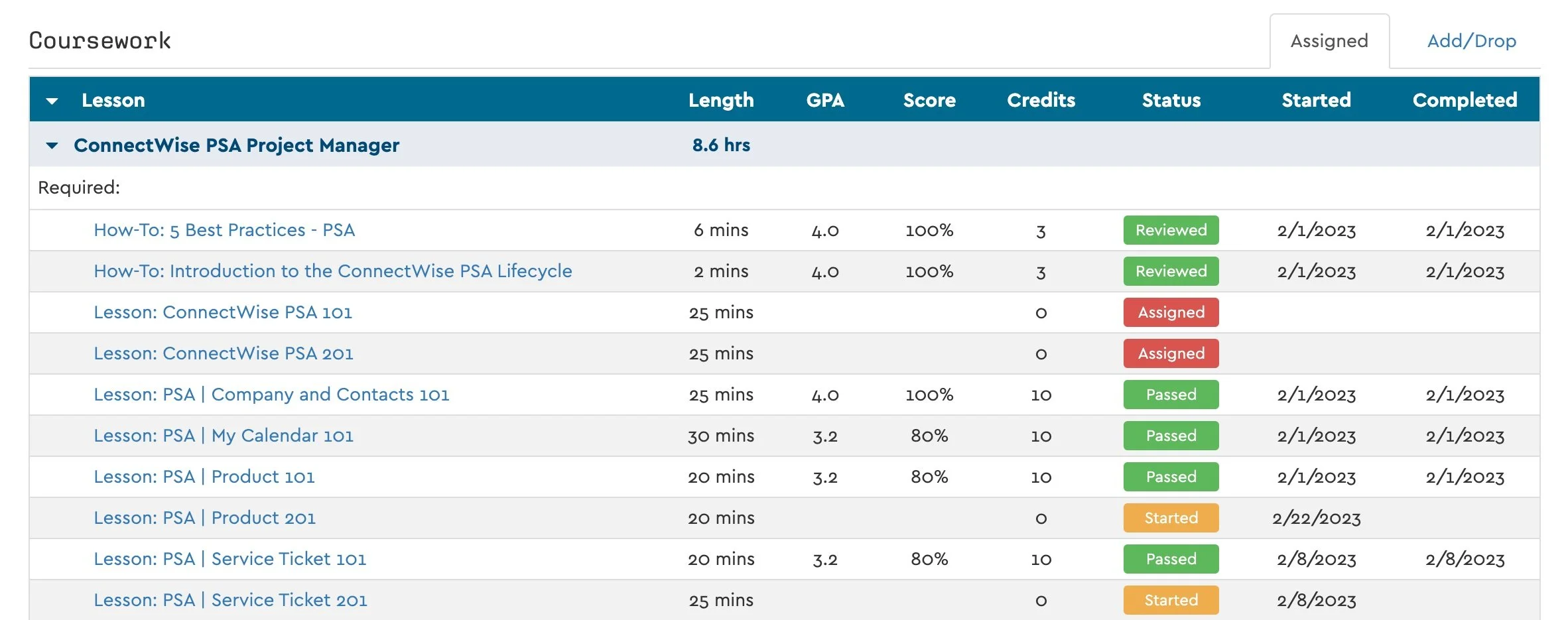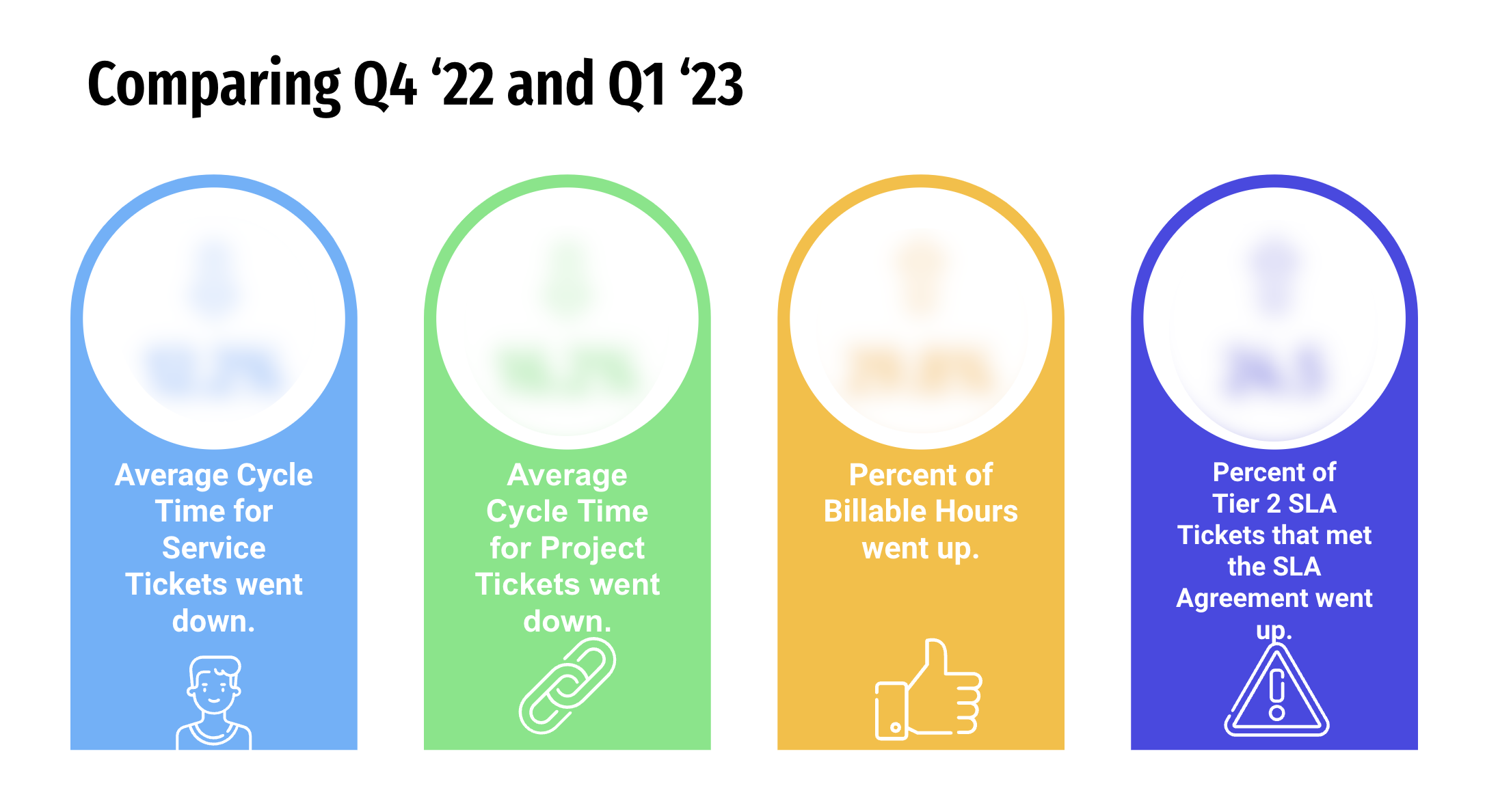Advantage Computing:
Leveraging Operational Efficiency
“Efficiency is doing things right; effectiveness is doing the right things.”
Vision: Optimize organizational processes in order to reduce employee overload while continuing to meet or exceed business goals.
Audience: Small business owner with a team of five employees serving over 75 companies and individuals.
Responsibilities: Needs Analysis, Stakeholder Engagement, Project Management, System Optimization
Tools: ConnectWise Manage, Microsoft 365, Whimsical, GitLab
KPIs:
Reduce Project and Service Ticket cycle times by 20%
Increase billable hours by 40%.
Problem
A quickly growing business is drowning in work without the resources to deliver on their agreements with clients.
Solution
Identify the gaps and pain points in internal processes and architect effective solutions through automation, team alignment and knowledge base development.
My Process
Needs Analysis
As a first step, I applied a range of business analysis tools in order to outline the business case for this process improvement project.
SWOT Analysis
These tools included
SWOT (Strengths, Weaknesses, Opportunities and Threats) Analysis
Goal Setting
Data Collection and Analysis
Empathy Interviews
Gap Analysis
Vision
The intention behind using these tools was to obtain an understanding of the objectives of the organization, understand where there were gaps in organizational processes and identify opportunities for growth and optimization. From there, I was able to build a business case for a series of changes and shifts in the way that work was done.
Constraints
Some of the built-in constraints from the onset of the project were:
The business was not in a place, financially, to onboard more employees. Therefore, the team would remain static.
The business was heavily-leveraged into a Managed Service Provider (MSP) platform. Therefore, we would not be adding new tools and would be working within the constraints of the current platform.
Staff were overwhelmed with day-to-day work. Therefore, their time to create, implement and develop solutions was limited.
Training
Because team bandwidth was limited, I had to quickly come up to speed on the MSP platform, understand how they utilized it and do everything I could to leverage its functionality to serve the team. ConnectWise Manage was not a platform that I was familiar with so I dove into the training modules and conducted research in order to understand how the platform functioned. I learned how to extract meaningful and actionable data from it, creating reports and building representations of that data to inform our baselines for the project.
ConnectWise Manage Coursework
Interviews
The last step before implementing changes was to interview individual employees about their workflows in order to understand where the gaps and opportunities were in their processes. These interviews not only gave me valuable insight into the barriers that individuals were experience in their day-to-day workflows, but they also empowered the team to take ownership of the changes that were required for optimizing those workflows. In addition, these interviews led to cross-functional conversations that allowed for transparency and collaboration between employees at different levels in the organization.
Through the conversations I had with team members, I learned that one of the main pain points for technicians was finding reliable and relevant client information. This information was spread across several different platforms and was not in a consistent format. This meant that technicians had to go searching for the information and often had to rely on information transferred orally from someone who had been at the company and had historical knowledge of the client. This slowed down response and resolution times for service tickets.
“A company can only scale as fast as knowledge can be retrieved.”
Goals and Objectives
Based on the empathy interviews, I worked with the company owner to develop organizational goals and objectives and a situation statement. These allowed us to anchor and align our work, staying focused on the most impactful changes and moves. Over time we created Key Performance Indicators (Key Results) and individual initiatives (Actions) to align with these goals.
Situation Statement
Distilling the business case down to a single statement allowed us to begin making changes with a clear purpose and vision.
Baseline Data
Prior to implementing any changes at the organizational level, I collected baseline data in order to establish benchmarks for Key Performance Indicators (KPIs). Tracking our KPIs enabled us to effectively monitor our progress towards the organization's objectives over time.
Continuous Improvement Process
Using a Continuous Improvement Process, we were able to take an iterative and human-centered approach to organizational change which resulted in significant improvements, quarter over quarter.
The Goal: Optimize Knowledge Retrieval
Based on the principle that “a company can only scale as fast as knowledge can be retrieved” (Nick Sonnenberg, 2022), our goal became to document and optimize the highest-leverage processes within the business. It was imperative to the success of the business that client documentation also be up to date, reliable and relevant. This allowed technicians and administrative staff to “retrieve knowledge” quickly and do their job effectively and efficiently. Therefore, whenever and new process was introduced or client information changed, the mandate was to document it. Whenever there was a complex process that involved multple team members, we documented it. Whenever a team member came across missing information or a process they were not familiar, we built a workflow that allowed them to request and ultimately share that documentation. “Document it!” became a repeated refrain.
The Challenges
Part-way through the year, three employees left the company for more lucrative opportunities within the space of three months. My focus broadened to onboarding new technicians to our systems for time management, Service Level Agreements, and client communication. In addition, I developed a company-wide Skills Matrix to aid in ticket dispatch as well as identifying skills gaps and creating customized learning paths for individual technicians. I also took on more administrative duties during this time, refining systems for tracking, scheduling and communicating with clients about their contracted IT services. While it was challenging to maintain a level of service that clients had come to expect during this transition, it highlighted that all the initiatives that we had put into motion around documentation, automation, and templating, were even more relevant than ever to the success and growth of the business.
The Results
By the end of my first year with Advantage and their second year of business, Advantage Computing was in the black, had a strong team of technicians plus a service/office manager, and was looking to grow their team and their client base in upcoming year. The owner was able to shift their focus from day-to-day operations and customer service to high level administrative duties and strategic business planning. Processes were standardized and documented, allowing technicians to be more autonomous and increasing team efficacy. Calendaring and scheduling practices led to transparency, autonomy, and improved customer communication. Finally, the bottom-up approach we had taken to identifying and resolving gaps, had empowered team members to continuously to find their own ways to improve the operational efficiency of the business as a whole. While there continued to be room for growth in these areas, the owner and the team members expressed that the documentation of processes had exponentially improved from where they had been the year prior.









